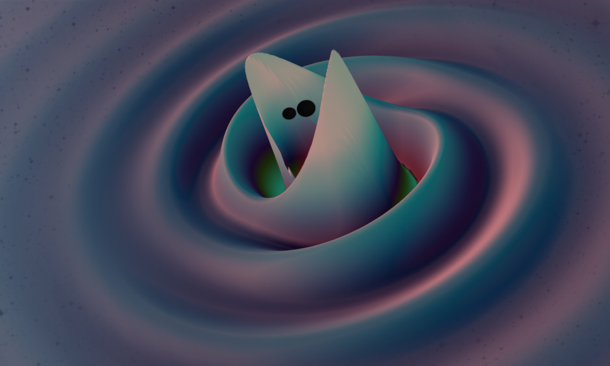Black holes are puzzling, exciting, and inescapable and are hence considered to be some of the most exotic objects in the Universe.

Ripples in the spacetime around a merging binary black-hole system from a numerical relativity simulation. Image Credit: Deborah Ferguson, Karan Jani, Deirdre Shoemaker, Pablo Laguna, Georgia Tech, MAYA Collaboration
With the availability of gravitational-wave detectors, detection of the chirp sound that two black holes produce when they merge is made possible, and around 70 such chirps have been discovered until now.
At the Heidelberg Institute for Theoretical Studies (HITS), a research group currently forecasts that this so-called “ocean of voices” chirps preferentially occur in two universal frequency ranges.
The study has been reported in The Astrophysical Journal Letters.
The breakthrough of gravitational waves in 2015—which was postulated by Einstein one hundred years ago—won the 2017 Nobel Prize in Physics and started the dawn of gravitational-wave astronomy.
When two stellar-mass black holes combine, they discharge gravitational waves of high frequency, the alleged chirp signal, that could be “heard” on Earth. From noting this frequency evolution (the chirp), researchers can deduce the alleged “chirp mass,” a mathematical combination of the two separate black hole masses.
Until now, it has been assumed that the merging of black holes could consist of any mass. But the team’s models indicate that few black holes come in standard masses that then lead to universal chirps.
The existence of universal chirp masses not only tells us how black holes form, it can also be used to infer which stars explode in supernovae.
Fabian Schneider, Study Lead Author, Heidelberg Institute for Theoretical Studies
It offers deep knowledge into the supernova mechanism, unsure nuclear and stellar physics, and offers a new method for researchers to quantify the expedited cosmological expansion of the Universe.
Severe Consequences for the Final Fates of Stars
Stellar-mass black holes with masses of around 3 to 100 times the Sun are considered to be the endpoints of massive stars that do not blow up in supernovae but collapse into black holes.
The black holes’ progenitors result in mergers that are originally born in binary star systems and face numerous episodes of mass exchange happening between the components: especially, both black holes are from stars that have been drawn off their envelopes.
“The envelope stripping has severe consequences for the final fates of stars. For example, it makes it easier for stars to explode in a supernova and it also leads to universal black hole masses as now predicted by our simulations,” stated Philipp Podsiadlowski from Oxford University, second author of the study and currently Klaus Tschira Guest Professor at HITS.
The “stellar graveyard”—known as a collection of all identified masses of the neutron-star and black-hole remains of massive stars—is rapidly increasing as a result of the accelerating sensitivity of the gravitational-wave detectors and continuing searches for such objects.
Especially, there appears to be a gap in the distribution of the chirp masses of combining binary black holes, and proof emerges for the existence of peaks at around 8 and 14 solar masses. Such features resemble the universal chirps forecasted by the HITS team.
Any features in the distributions of black-hole and chirp masses can tell us a great deal about how these objects have formed.
Eva Laplace, Study Third Author, Heidelberg Institute for Theoretical Studies
Not in This Galaxy: Black Holes with Much Larger Masses
Ever since the first breakthrough of merging black holes, it became obvious that there are black holes with much greater masses compared to the ones found in the Milky Way.
This is a direct impact of such black holes originating from stars born with a chemical composition different from that in the Milky Way Galaxy.
Currently, the HITS team could display that—irrespective of the chemical composition—stars that are envelope-stripped in close binaries develop black holes of <9 and >16 solar masses but nearly none in between.
In merging black holes, the universal black-hole masses of roughly 9 and 16 solar masses logically imply universal chirp masses, that is, universal sounds.
When updating my lecture on gravitational-wave astronomy, I realized that the gravitational-wave observatories had found first hints of an absence of chirp masses and an overabundance at exactly the universal masses predicted by our models.
Fabian Schneider, Study Lead Author, Heidelberg Institute for Theoretical Studies
Schneider added, “Because the number of observed black-hole mergers is still rather low, it is not clear yet whether this signal in the data is just a statistical fluke or not.”
Whatever may be the outcome of future gravitational-wave observations: the outcome will turn out to be exciting and help researchers comprehend better where the singing black holes in this ocean of voices derive from.
Journal Reference
Schneider, F. R. N., et al. (2023) Bimodal Black Hole Mass Distribution and Chirp Masses of Binary Black Hole Mergers. The Astrophysical Journal Letters. doi.org/10.3847/2041-8213/acd77a.